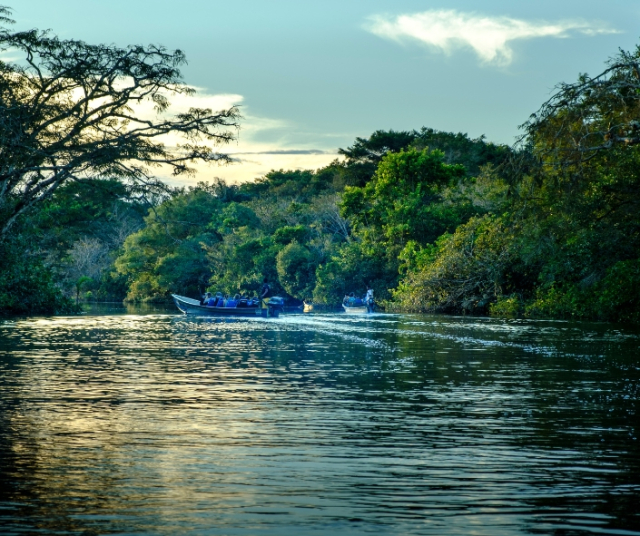Ecuador, a country blessed with lush biodiversity and diverse geography, is home to an extensive network of rivers that play a crucial role in the lives of its inhabitants and in the ecological balance of the country. From the majestic mountains of the Andes to the vast plains of the Amazon, Ecuadorian rivers are true arteries of life that nourish the land and sustain biological diversity. In this article, we will carefully explore Ecuador's main water sources, their historical, cultural and ecological importance, as well as the challenges and opportunities they face in the 21st century.
Water sources in Ecuador, represented by its numerous rivers that meander through the country's various regions, play a fundamental role in daily life, the economy and the environment. These rivers are vital for the communities' drinking water supply, providing an indispensable resource for human consumption, agriculture and industry. Additionally, they are the backbone of Ecuadorian agriculture, feeding the irrigation systems that sustain crops and promoting agricultural production in the fertile alluvial valleys. The biodiversity that Ecuadorian rivers are home to is impressive, offering refuge and habitat for a wide variety of flora and fauna species, many of which are endemic and in danger of extinction. Protecting these aquatic ecosystems is crucial to safeguarding the country's biological diversity and maintaining the ecosystem services they provide.
In addition to their ecological importance, Ecuadorian rivers also play a vital role in the country's economy and development. They have been historically important as trade routes and transportation routes, facilitating the exchange of goods and connection between different regions of the country. Likewise, hydroelectric power generation from rivers contributes significantly to the country's electricity supply, providing a clean and renewable energy source. On the other hand, rivers are also an important tourist attraction, offering opportunities for recreational activities such as rafting, sport fishing and ecotourism, which generate income and employment in local communities.
The Andean Rivers: The Cradle of Water.
Guayas River: The Coastal Giant
The Guayas River, with its more than 360 kilometers in length, is the most emblematic river in Ecuador. Originating on the western slope of the Ecuadorian Andes, the Guayas meanders through the coastal region before emptying into the Gulf of Guayaquil. This majestic river has witnessed the history and development of the country, and its basin is home to a great diversity of flora and fauna, as well as important urban centers such as Guayaquil, the largest and most populated city in Ecuador.
Esmeraldas River: The Essence of the Northwest
The Esmeraldas River, with a length of approximately 320 kilometers, is one of the main rivers in northwest Ecuador. Born in the foothills of the Andes, this river flows through the province of Esmeraldas, a region known for its rich cultural and natural diversity. The Esmeraldas plays a vital role in the local economy, providing water for agriculture, fishing and hydroelectric power generation.
Babahoyo River: The Voice of the Center
The Babahoyo River, more than 240 kilometers long, is one of the main tributaries of the Guayas River. Originating in the Andean mountain range, the Babahoyo collects the waters of the central region of Ecuador and takes them to the Gulf of Guayaquil. This river is vital for agriculture in the region, as it provides water for irrigation of the fertile valleys that border its course.
Patate River: Beauty in the Andes
The Patate River is a tributary of the Pastaza River, which in turn is part of the Amazon basin. This river rises high in the Andes and descends through spectacular landscapes, feeding fertile valleys and lush jungles on its way to the Amazon rainforest. The Patate River is known for its scenic beauty and its importance for nature tourism in the Andean region.
The Amazon Rivers: Life in the Jungle
Napo River: The Great Navigable
The Napo River, with a length of more than 1,000 kilometers, is one of the main tributaries of the Amazon River. Born in the heights of the Andes, the Napo passes through the dense Amazon jungle before joining the Amazon in Peruvian territory. This river is vital for navigation, the transportation of goods and the life of the indigenous communities that live on its banks.
Pastaza River: The Force of Nature.
The Pastaza River, more than 700 kilometers long, is another important tributary of the Amazon River. Born in the Ecuadorian Andes, the Pastaza flows through mountainous landscapes and rainforests, feeding rich biodiversity on its way to the Amazon basin. This river is essential for fishing, agriculture and tourism in the Amazon region.
Putumayo River: The Natural Frontier.
The Putumayo River marks the border between Ecuador and Colombia in the Amazon region, being an important biological and cultural corridor for the indigenous communities that live in the area. With a length of more than 800 kilometers, the Putumayo is essential for fishing, agriculture and the conservation of biodiversity in the region. In addition, this river is an important resource for the generation of hydroelectric energy in the area.
Challenges and Opportunities.
Despite their importance, Ecuador's rivers currently face numerous challenges. Deforestation, pollution and climate change threaten the health and integrity of these aquatic ecosystems. However, there are also opportunities for its conservation and sustainable management. The creation of protected areas, the implementation of sustainable agricultural practices and the strengthening of environmental legislation are some of the measures that can help protect these valuable natural resources for future generations.
The rivers of Ecuador are true treasures of water and life that deserve to be protected and conserved. From the peaks of the Andes to the depths of the Amazon rainforest, these rivers are essential to the country's life and culture, providing fresh water, food and habitat for a countless variety of species. Protecting and conserving these rivers is a shared responsibility of all Ecuadorians and an invaluable legacy for future generations.
